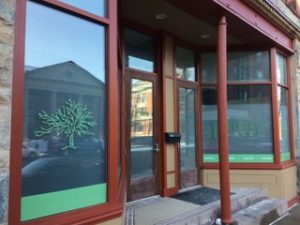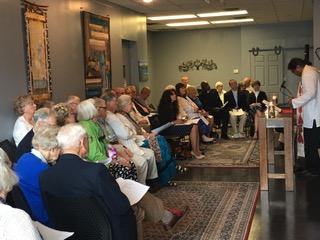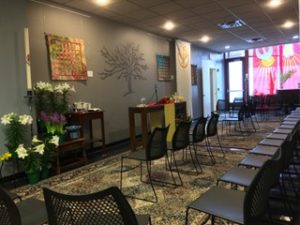written by Cameron Miller
Family lore has it that we are somehow related to Oliver Cromwell’s wife. It may be DNA, an act of God, or just plain karma that so much of my nearly forty years of ministry has been involved in saving or restoring historic Church buildings. (In fairness to Cromwell, modern scholarship suggests he was not actually such a blameworthy source of mass architectural destruction).
The first congregation I served as rector, had a humble and unremarkable 1960’s brick building in serious need of restoration by the 1980’s. The second congregation was on the cover of LIFE Magazine when new in the 1950’s, but by the 1990’s it was a heat-leaking, fogged glass, crumbling brick money pit. Next came a hulking nineteenth century stone monster with world renowned Lafarge and Tiffany windows – all on a rundown campus of four buildings. The-ace-in-the-hole for that congregation was parking for seventy-five at the urban core.
After giving thirty-three years to those three tenures as rector, I took my pension and went part-time to more fully pursue my other vocation – as a writer. It was pure irony that my first part-time venture was serving a congregation who were the stewards of a tiny, hundred-seat, nineteenth century wooden structure older than all the other demanding buildings in which I had served. That little church in northernmost Vermont was supported from below by huge pristine smooth, stripped-bark tree trunks in an earthen undercroft accessed by a trapped door – all of it clean as a whistle.
Currently, I am helping a congregation escape from a beautiful limestone neo-gothic giant rebuilt to mimic Trinity Wall Street after a fire in the 1930’s. Besides the failing boilers, water and heat pipes springing leaks through the floors and walls as if a mesh colander, all basic systems are in ruins along with a roof that must be replaced.
Of the above, only that little nineteenth century wooden structure did not depress and repress the mission and ministry of its congregation. While I have been fortunate enough to help each congregation grow – doubling average weekly attendance in one and tripling it in another – in no instance was growth in membership enough to keep the building-tail from wagging the mission-dog.
Over fourteen years in the most capital intensive of them all, the one with Lafarge and Tiffany windows, we put more than three million dollars into the campus. Two capital campaigns and over a million dollars in grants later, the growling of hazards to come could still be heard. Through aggressive rental programs and adaptive reuse, we housed important community organizations and made a quarter of a million dollars annually for the bottom line. Still, it was not enough. In order to reduce the drain on endowments, the staff was cut from twenty full and part-time members when I arrived, down to nine when I retired. Even so, the worshipping congregation grew to three hundred or more per week. Still, not enough. So much time and energy went toward feeding the building that in spite of an exceedingly vibrant community and creative programs, the outreach was pale in comparison.
As for my current cure, I was called by the small congregation to help determine if they had a future after being in decline for twenty years and no longer able to support its building. In my first sermon I was clear: I could be a midwife or a hospice chaplain, but it was their choice. After a nine-month discernment process in which options were investigated, they chose.
We found a developer who was interested in creating a boutique hotel with a small restaurant and event center. The sanctuary would be restored with only the pews removed and, unbelievably, he would welcome us to worship there on Sunday mornings and special occasions. Zoning issues were arduously worked out with the municipality, and while some neighbors have filed a relentless series of lawsuits, we have been prevailing all along in courts.

But something has happened to change everything. We leased and moved into a former wine bar downtown.
For the past year, “Trinity Place” as we named it, has served as a worship space on Sunday mornings and offered yoga classes during the week. Local quilters, photographers, and painters are using it as a space for gallery openings and display, which in turn graces the worship. A poet and painter recently did a collaboration, and two authors have hosted book launches from the space. The League of Women Voters, “Dancer for Peace,” a women’s philanthropy non-profit, an immigrant ally group, and numerous other organizations have met at Trinity Place as well. The protocol is for free use to non-profit groups and a five percent contribution requested from classes and workshops that charge a fee. All on-going groups are encouraged to think of themselves as building partners rather than mere users, and the congregation is asked to see its space as a resource for the wider community not just their own.
The Steinway that sounded lovely in the big historic sanctuary is an out of this world sound in our new space. Thirty to forty voices singing in a sanctuary that seats five hundred cannot compare to those same voices in a space for sixty. The effect of the artwork and quilts compares favorably with stained glass windows. When it is Christmas, Easter, All Saints’ or some other occasion to which we want add a little formality, then the chairs are set up church-style in rows. But when the emphasis is more immanent than transcendent, which for us now is most of the time, we can worship in a semi-circle. Yes, we lost the organ, choir, and stained glass, but we no longer fight architecture. We are able to change patterns, format, and liturgy with regularity, and so our worship is far more vibrant. The entire congregation is the choir. A new person recently said that coming to Trinity Place was like being in a “thin place.” It turns out such a sense of the sacred is not limited to transcendent architecture and can be encountered in an old wine bar.
The days are coming when big historic buildings for worshipping congregations will be an anomaly. Perhaps there will be one or two left in small towns and suburbs, maybe here and there in cities, but congregations will be meeting elsewhere if they are to survive. The economies of scale for all non-profits have changed radically, and the same dynamics forcing neighborhood hardware stores to close in favor of big box stores like Home Depot, are forcing small congregations to leave their buildings. The data is all around us.
Convincing a vibrant congregation of three-hundred or more that they are on the brink, is no easy task. I failed at it myself. Yet that is what judicatories and congregational leadership should be doing everywhere – providing a vision of the future with alternatives to historic buildings. We need to be helping congregations find buyers or developers willing to commit to long-term leasing and adaptive reuse of our buildings, or selling them outright. Preservation of art and architecture is not our mission.
Our mission is to be midwives of the kingdom on earth as it is in heaven. That is no easy task and it takes enormous energy, courage, strength, and effort. Clearly, we haven’t gotten very far with it either. So, if the funding and maintenance of our buildings does not diminish opportunities and resources f or mission, great. Otherwise, we need to give up the ballast in order to rise.
I know the conflict, grief, and gnashing of teeth involved in initiating that conversation, and yet, it is a life-saving and hope-enabling opportunity. For hundreds if not thousands of congregations throughout the country, it is a conversation that needs to begin even when there are many people left in the pews and dollars still earning interest in the endowment. That requires true leadership and passion for mission. Strategic initiates from clergy and lay, at both the judicatory and congregational level, are crucial in order to get congregations talking and imagining new futures beyond their buildings – before the die is cast and options become few and grave.
The Rev. Cameron Miller is a writer and preacher exploring the sacred hiding in plain sight. That theme is embedded in his fiction and poetry, along with essays published weekly in his newspaper column, Denim Spirit (Finger Lakes Times – New York). His latest novel, Thoughtwall Café: Espresso in the Third Season of Life, and a collection of poems and essays to be released in July, Cairn, are both published by Unsolicited Press. Read more at his website:
www.subversivepreacher.org.


